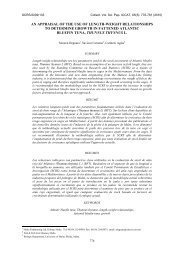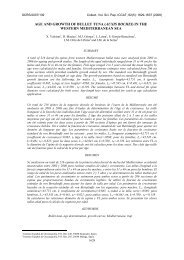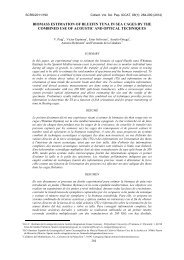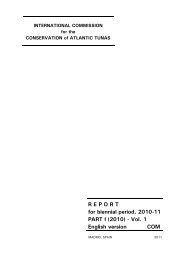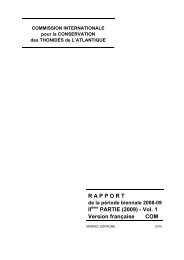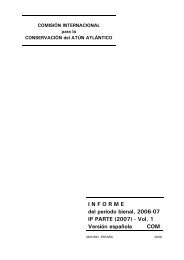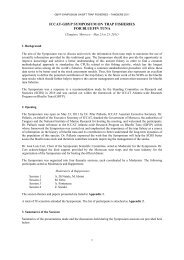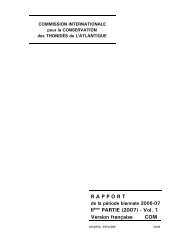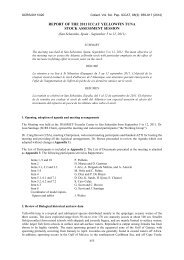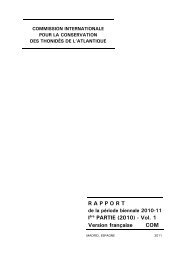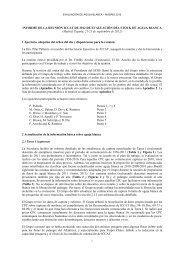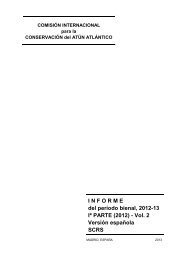E - Iccat
E - Iccat
E - Iccat
Create successful ePaper yourself
Turn your PDF publications into a flip-book with our unique Google optimized e-Paper software.
PANEL APPENDICES<br />
Further Considering that the SCRS recommends that, starting in 2003, the level of total catch in the Atlantic be<br />
maintained at the 2001 catch level, in order to restore the biomass of bigeye tuna to a level which would allow<br />
MSY to be attained;<br />
The International Commission for the Conservation of Atlantic Tuna (ICCAT) recommends:<br />
1. Each Contracting Party and Cooperating non-Contracting Party, Entity or Fishing Entity shall, in 2004, limit<br />
their catch of Atlantic bigeye tuna to the average catch of Atlantic bigeye tuna taken by all their vessels in<br />
1991 and 1992.<br />
2. Notwithstanding the paragraph above,<br />
a) China shall limit, in 2004, its catch of bigeye tuna to 5,000 t, while the overall number of its vessels<br />
registered with the Commission be frozen at 60 for 2004 and thereafter, unless the Commission decides<br />
otherwise.<br />
b) The Commission shall request Chinese Taipei to limit, in 2004, its catch of Atlantic bigeye tuna to 18,500t<br />
and the number of its fishing vessels fishing for Atlantic bigeye tuna to 125.<br />
c) The Commission shall request the Philippines to limit, in 2004 and thereafter, the number of its fishing<br />
vessels fishing for Atlantic bigeye tuna to five (5).<br />
3. The provision of paragraph 1 will not apply to Contracting Parties, Cooperating non-Contracting Parties,<br />
Entities or Fishing Entities whose reported 1999 catch, as provided to the SCRS in 2000, was less than 2,100 t.<br />
4. Underages/overages of the 2004 catch limit for bigeye tuna may be added to/must be subtracted from the 2005<br />
and/or 2006 catch limits for bigeye tuna.<br />
Explanatory Memorandum for Proposed Recommendation on Bigeye Tuna Conservation Measures<br />
In view of the uncontrollable rapid increase of large scale FOC/IUU longline fishing vessels in the late 1990s,<br />
and in their determination of eliminating the unregulated fishing activities of these longline fishing vessels so as<br />
to achieve the goal of sustainability of tuna resources for the utilization of future generations, in February 1999,<br />
Japan and Chinese Taipei signed an Action Plan, whereby Japan was to scrap those second hand longliners it<br />
exported and Chinese Taipei was to encourage those longliners recently built in its shipyards to acquire<br />
registration, so that they would be properly managed and controlled. In 1999, ICCAT adopted a resolution,<br />
praising Japan’s scrapping program and Chinese Taipei’s re-registration program to reduce FOC vessels and<br />
asking them to continue strengthening their joint program (see ICCAT Report 2000-2001, Appendix 9 to<br />
ANNEX 14, pp. 372).<br />
The Commission may also note the joint program to combat and eliminate IUU fishing activities is a prominent<br />
one. Japan has scrapped 42 ex-Japanese IUU/FOC large-scale tuna longliners and Chinese Taipei has reregistered<br />
45 IUU/FOC tuna longliners newly built in our shipyards. In addition, under the joint efforts between<br />
Japan and Chinese Taipei, in cooperation with Vanuatu and Seychelles, a special arrangement has been made to<br />
legitimize 69 IUU/FOC large-scale tuna longliners. Practically speaking, all the IUU/FOC vessels built within<br />
the recent five years have been almost eliminated. Among the ex-IUU vessels, 26 vessels were operating in the<br />
Atlantic Ocean, including 13 scrapped and 13 re-registered. Scrapping of the 13 vessels would reduce a catch of<br />
some 3,250 t of tuna (estimated catch of 250 t per vessel, as suggested by Japan, see ICCAT Report 2002-2003<br />
(I), Appendix 1 to ANNEX 12, pp. 292, Report by Japan on the Current Situation of IUU LSTLVs) and reregistering<br />
the 13 vessels would enable to bring these vessels under proper control and their catches would be<br />
regulated and reported by our government. From the above description, the Commission should be glad to hear<br />
that we have nearly achieved such a goal. Whereas the implementation of this joint program has caused an<br />
increase in the size of our fleet. We hope the Commission will consider an increase the catch limit of tuna to<br />
accommodate such an adjustment, since the present catch limit to be shared among the legitimate licensed<br />
vessels is already too low for the fleet to be viable.<br />
Of the 13 re-registered vessels operating in the Atlantic, 11 are targeting bigeye tuna. They will require an extra<br />
catch limit of 2,750 t, basing on a catch of 250 t per vessel. Keeping in mind the common concept not to benefit<br />
the IUU vessels, if 250 t are allocated to the re-registered vessel, it might read as they are in fact receiving a<br />
preferential treatment than the legitimate licensed vessels that are getting 183 t each. Therefore, we are applying<br />
the same regulatory measure of catch limit to the re-registered vessels of 183 t per vessel. In other words, these<br />
11 vessels will require an additional catch limit of 2,013 t (i.e. 183 t x 11). After re-registration, these 11 vessels<br />
will in fact be utilizing 740 t less than if they remain uncontrolled.<br />
199



